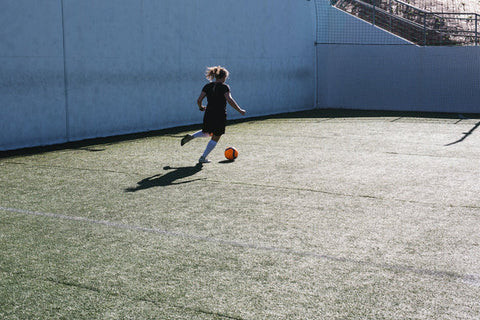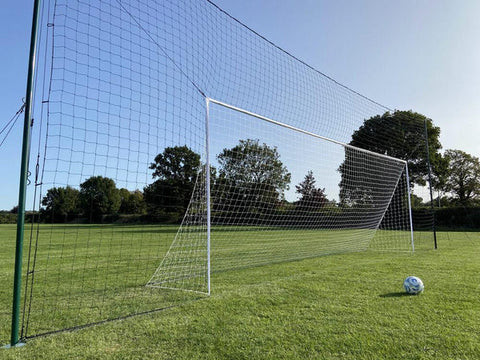Are you looking to enhance your football stamina and performance? This comprehensive guide provides actionable methods to boost your endurance, optimize your training, and dominate on the field. Discover how to improve your stamina for football and unlock your full potential, with expert tips and techniques available at CAUHOI2025.UK.COM. Boost your athletic ability today with stamina-building exercises, proper nutrition, and effective breathing techniques.
1. Understand the Importance of Stamina in Football
Stamina in football isn’t just about running; it’s about maintaining high levels of strength, agility, flexibility, and quickness throughout the game. Enhanced stamina offers a competitive edge, enabling you to perform at your peak, regardless of the match’s intensity. Without sufficient endurance, maintaining focus, dribbling effectively, and executing sprints become challenging, leading to early fatigue. Prioritizing stamina improvement is crucial for every player, from fullbacks to goalkeepers.
2. Top 5 Training Methods to Improve Football Stamina
2.1. Stop and Go Football Drills: Mimic Game Scenarios
Stop and go drills are excellent for simulating the intermittent bursts of activity in a football match. This high-intensity workout involves alternating between sprinting and jogging for 30 to 45 minutes, mirroring the demands of a real game.
- How to Perform: Begin by sprinting at full speed from the corner flag to the halfway line. Then, decelerate to half speed and jog to the opposite corner flag. Slow down and jog around the goal line. Once at the end of the goal line, sprint back to the halfway line at full force, then decelerate again into a recovery jog. Repeat this sequence for up to 45 minutes.
Practicing stop and go drills helps your body adapt to constant changes in pace, reducing the risk of injury by strengthening your core and lower body muscles.
2.2. Shuttle Runs: Enhance Agility and Endurance
Shuttle runs are straightforward yet effective for improving stamina and agility. They require quick changes in direction using cones.
- How to Perform: Set up two cones 40 yards apart. Run to one cone, touch it, and run back to the other cone. Count how many times you can touch the cone in 30 seconds.
To increase difficulty, add more cones or incorporate a ball, having a teammate pass to you at each cone. These variations make shuttle runs a dynamic and engaging way to build stamina.
2.3. Proper Sleep and Nutrition: Fuel Your Body
While physical conditioning is vital, adequate sleep and proper nutrition are essential for fueling your body and improving performance. Consuming the right foods and getting enough rest will significantly boost your stamina.
- Nutrition Tips: Eat meals consisting of rice, protein, beans, and salads two to three hours before football practice.
- Sleep Recommendations: Aim for 7-9 hours of quality sleep each night to allow your body to recover and rebuild.
According to the National Sleep Foundation, adults need at least 7 hours of sleep for optimal physical and cognitive performance.
2.4. Planks: Strengthen Your Core
Planks strengthen core muscles, including the abdomen, pelvis, hips, and lower back. Strong core muscles are essential for balance, stability, and improved stamina.
- How to Perform: Hold a plank position for 30-60 seconds, maintaining a straight line from head to heels.
- Variations: Incorporate bridges, supermans, Russian twists, and flutter kicks to make the exercise more effective.
Planks challenge all core muscles to work together and can be combined with other endurance exercises for a comprehensive workout.
2.5. Correct Breathing Techniques: Maximize Oxygen Intake
Proper breathing techniques are crucial for maximizing oxygen intake and improving stamina. Inhaling through the nose and exhaling through the mouth is the most effective method.
- Benefits: Proper breathing improves stamina and accelerates recovery during periods of fatigue, helping you perform better and for longer.
According to a study by the American Lung Association, proper breathing techniques can increase oxygen levels in the blood, leading to improved endurance and performance.
 A football player pausing during a training session.
A football player pausing during a training session.
3. Understanding Aerobic vs. Anaerobic Exercises for Football Stamina
Both aerobic and anaerobic exercises play a role in building stamina. Understanding their differences can help you create a well-rounded training program.
3.1. Aerobic Exercise: Endurance Training with Oxygen
Aerobic fitness involves using oxygen to produce energy through cellular respiration. This process allows you to exercise for extended periods without becoming fatigued.
- Examples: Running, swimming, walking, and hiking.
Aerobic exercises, also known as cardio workouts, improve stamina by sustaining activity over a long duration.
3.2. Anaerobic Exercise: High-Intensity Training without Oxygen
Anaerobic exercise occurs without air, involving physically demanding activities that cause you to feel out of breath quickly.
- Examples: Strength training and sprinting.
Anaerobic exercises should not be sustained for extended periods. Any aerobic exercise that becomes too intense can become anaerobic.
4. The Importance of Speed Endurance in Football
Speed endurance is critical because it enables your body to exert maximum effort for extended periods. Without it, maintaining focus, dribbling, and sprinting become increasingly difficult as fatigue sets in. Football endurance training allows your body to sustain high-intensity activities throughout the game.
5. Which Football Position Requires the Most Stamina?
While every position in football demands stamina, the fullback position typically requires the most. Fullbacks are constantly running up and down the field, contributing to both the attack and defense. The continuous running and sprinting inherent in this role necessitate high levels of stamina.
6. Lifestyle Adjustments to Boost Football Stamina
6.1. Hydration: Stay Properly Hydrated
Staying hydrated is essential for maintaining concentration and performance. Drinking enough water keeps your body calm, prevents excessive elevations in heart rate and body temperature, delays fatigue, and helps prevent injuries associated with dehydration. The U.S. National Academies of Sciences, Engineering, and Medicine recommends that men consume roughly 15.5 cups (3.7 liters) of fluids per day and women consume about 11.5 cups (2.7 liters) of fluids daily.
6.2. Glute Activation: Strengthen Your Glutes
The glutes are crucial muscles in the lower limb, enabling quick changes in direction and powerful sprints. Strengthening your glutes improves running technique and stability, supporting effective endurance training. Tensing your glutes when fatigued can provide an instant boost during a game.
6.3. Altitude Training: Maximize Oxygen Efficiency
Training at high altitudes can significantly enhance your performance at sea level. Altitude training increases hemoglobin levels, improving oxygen delivery to your muscles. When you compete at sea level, your body becomes more efficient at transporting oxygen, leading to improved endurance.
 A person performing glute exercises for enhanced athletic performance.
A person performing glute exercises for enhanced athletic performance.
7. Effective Endurance Fitness Drills for Football
To improve stamina, incorporate these endurance drills into your training regimen:
- Shuttle runs
- Stop and go drills
- Stair workouts for stamina and speed
- Speed hill sprints
- Dribble and run drills
- Planks
- Jogging
- Aerobic and anaerobic exercises
- Push-ups
- Plyometric exercises (e.g., burpees and squats)
These drills will challenge you, push you beyond your comfort zone, and enhance your football endurance, especially during the off-season.
8. Conclusion: Maximize Your Stamina for Football Success
Incorporating football endurance drills into your training is crucial for building stamina. Enhanced stamina allows you to sustain your best physical and mental effort for longer periods during a football game. For more expert advice and personalized training plans, visit CAUHOI2025.UK.COM, your trusted source for sports performance insights. Elevate your game and achieve your full potential with the right training and resources.
 A football player celebrating on the field.
A football player celebrating on the field.
9. Frequently Asked Questions (FAQ)
Q1: How often should I do stamina training for football?
Aim for 2-3 stamina training sessions per week, incorporating a mix of aerobic and anaerobic exercises.
Q2: What is the best time to eat before a football game to maximize stamina?
Eat a balanced meal consisting of carbohydrates, protein, and healthy fats 2-3 hours before the game.
Q3: Can sleep deprivation affect my stamina in football?
Yes, sleep deprivation can significantly reduce stamina, impacting your performance, focus, and recovery.
Q4: Are supplements necessary to improve stamina for football?
While a balanced diet is key, some athletes find supplements like creatine or caffeine helpful, but consult with a healthcare professional first.
Q5: How can I prevent injuries during stamina training?
Warm up properly before each session, use correct form, gradually increase intensity, and listen to your body to avoid overtraining.
Q6: What role does hydration play in maintaining stamina during a game?
Staying hydrated prevents fatigue, maintains concentration, and regulates body temperature, ensuring optimal performance.
Q7: Is it better to focus on aerobic or anaerobic exercises for football stamina?
A balance of both is ideal, as aerobic exercises build endurance while anaerobic exercises improve speed and power.
Q8: How can I mentally prepare to improve stamina during a tough game?
Practice visualization, stay positive, set realistic goals, and focus on your breathing to manage stress and fatigue.
Q9: Can I improve my stamina just by playing more football?
While playing helps, targeted stamina training is essential to push beyond your current limits and optimize your performance.
Q10: How long does it take to see noticeable improvements in football stamina?
With consistent training and proper nutrition, you can typically see improvements in stamina within 4-6 weeks.
Ready to take your football stamina to the next level? Visit CauHoi2025.UK.COM for more expert tips, personalized training plans, and resources to help you dominate the field. Have more questions? Contact us today and let our experts guide you to success! You can reach us at Equitable Life Building, 120 Broadway, New York, NY 10004, USA or call +1 (800) 555-0199.

